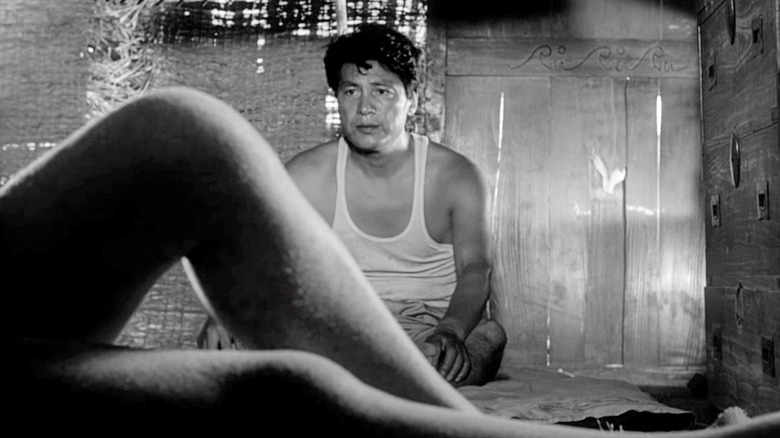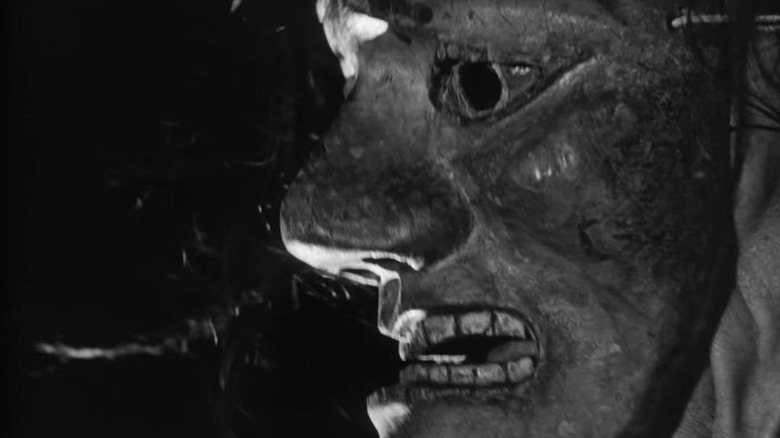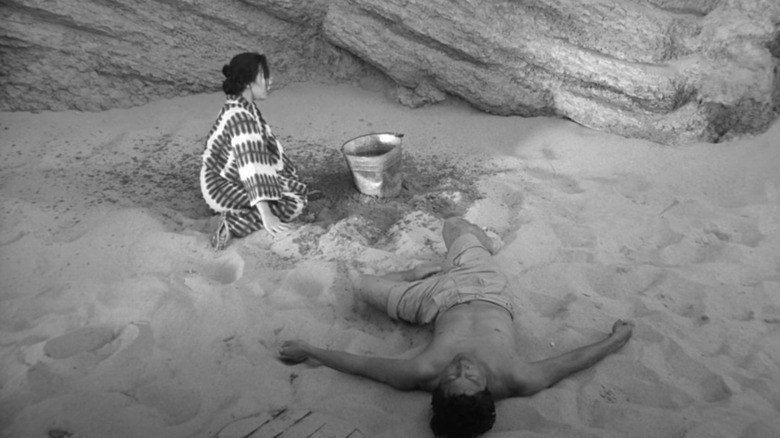The Daily Stream: Woman In The Dunes Finds Grains Of Truth In A World Of Sand
(Welcome to The Daily Stream, an ongoing series in which the /Film team shares what they've been watching, why it's worth checking out, and where you can stream it.)
The Movie: "Woman in the Dunes"
Where You Can Stream It: The Criterion Channel
The Pitch: A bug-hunting schoolteacher finds himself stranded in a sandpit with a woman, at the mercy of demented villagers, and forced into a life of shoveling sand.
In Japan, where rural population decline is an ongoing problem, there are places in the countryside that will actually pay people to live there. As 2023 began, the BBC and CNN reported that the government has upped its incentive program to 1 million yen per child for families willing to move away from the crowded capital of Tokyo to less thriving towns.
The villagers in "Woman in the Dunes" have devised a different scheme. They prey on solo travelers like Junpei Niki (Eiji Okada), who falls asleep in the sand while on holiday from city life and misses the last departing bus. In this way, Hiroshi Teshigahara's 1964 New Wave film follows the familiar (then, incipient) folk-horror scenario of an urbane individual who gets waylaid out "in the boonies," as the village elder (Koji Mitsui) puts it. It even conjures up a nightmarish fertility ceremony of sorts, complete with ritual masks.
The elder leads Junpei to shelter in the strangest of places: a hut at the bottom of a sandpit, which can only be accessed by rope ladder. There, Junpei's search for tiger beetles ends in indentured servitude, as he takes up with an unnamed widow (Kyoko Kishida) and learns the sand-shoveling system. You've heard of Yuki-onna, the snow woman of Japanese ghost lore. This is Suna no Onna, a woman who sleeps naked, her body encrusted in sand.
Why it's essential viewing
Beyond its bona fides as a Cannes-winning, Oscar-nominated member of the 100% Tomatometer club, "Woman in the Dunes" endures as just an effective piece of storytelling. Without a radio to bring in news of the outside world, Junpei's predicament takes on a timeless quality. The visual metaphor of sand also gives his story an elemental power that cuts through cultural differences and the film's more avant-garde touches.
As Junpei settles into his new life with the woman, composer Toru Takemitsu's screechy music gives it an unnerving edge, while cinematographer Hiroshi Segawa's extreme close-ups of grains of sand and beads of water on skin render the mere act of brushing or scrubbing sensual. The sand, piled high above the couple in their work pit, also evokes a strong sense of place. It sticks to everything but slips right through one's fingers. When Junpei tries to climb it, we see how it flows downhill and crumbles underfoot.
What drew me personally to "Woman in the Dunes" was the name Kōbō Abe, who adapted his own novel into the screenplay for this movie. Another book of Abe's, "The Ruined Map," made a vivid impression on me the year I moved to Tokyo. It's a detective novel where the idea of "getting lost" extends to the protagonist's identity.
Tokyo is often referenced but never seen in "Woman in the Dunes." The real-life metropolis has a kind of dream logic — far removed from any grid pattern — to the layout of its streets. There are times even today when Google Maps might fail you and those often-nameless streets might lead a person down a similar head-swimming path of confusion. Not really knowing the geography of where he is also works against Junpei in his escape attempts in "Woman in the Dunes."
'Shoveling sand to live, or living to shovel sand?'
Despite Junpei's surreal circumstances (not to mention his chauvinistic tendency to insult his host's intelligence in one breath and praise her cooking in the next), his plight is oddly not all that dissimilar from any person eking out a living in contemporary society. You don't have to run afoul of exploitative taskmasters and be lowered into a sandpit to get yourself down in a hole of debt or false hope. Quicksand is everywhere, and people live in prisons of their own making.
Roger Ebert called "Woman in the Dunes" "a modern version of the myth of Sisyphus," and as Junpei wrestles with cynicism and the futility of his daily endeavors, the viewer is left to wonder which is worse: accepting a trap as one's lot in life, or missing out on potential companionship and happiness in an otherwise hardscrabble existence.
There are conflicting reports about where "Woman in the Dunes" was shot. Some sources cite the Tottori Sand Dunes as the shooting location, while others insist that it was the Hamaoka Sand Dunes in Shizuoka Prefecture. I lived in Shizuoka before and visited Tottori just last year, so the memory of what it's like to trudge up a mountainous sand dune, where the specks of distant people resemble ants on a hill, is recent.
"Life here is like building a house on water," Junpei laments to the woman, but water is in short supply, and the more obvious comparison would be building a house on sand. "Woman in the Dunes" begins with images of calligraphy, fingerprints, and hanko name stamps: signifiers of identity on official documents. In voiceover, we hear Junpei laundry-listing the many different "certificates we use to make certain of one another." In the end, it's all just sand.


